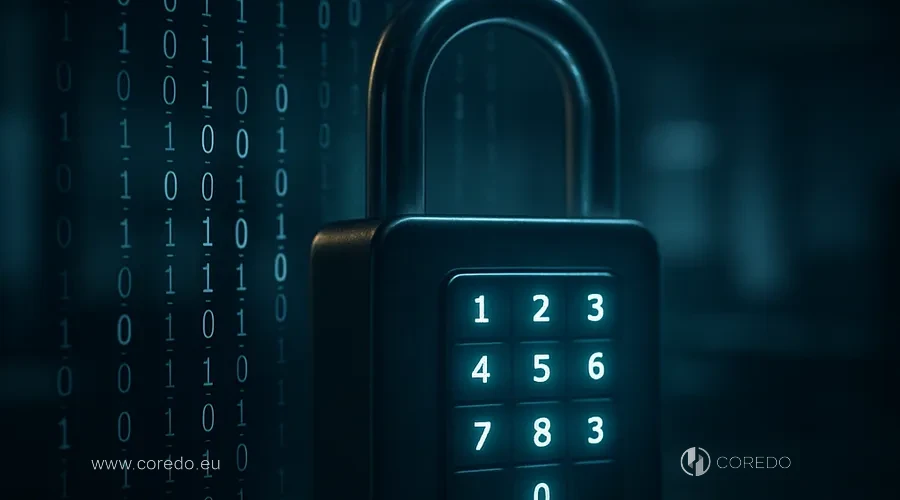Every 39 seconds there is an attempted cyberattack worldwide, and the average cost of a personal data breach for an international company will exceed $4.5 million by 2025. But the figures are only the tip of the iceberg. The real blow: the loss of customer trust, paralysis of business processes and legal consequences that can threaten the very existence of a company.
Imagine: one unsecured account – and your data are already on the shadow market, while competitors and attackers discuss them on the Dark Web.
At COREDO my team and I have faced such challenges more than once – and each time developed solutions that allowed our clients not only to survive the crisis but to emerge stronger.
Personal data breach – what it is and the threat to business?

Causes: from phishing attacks and targeted cyberattacks to internal vulnerabilities and access management errors.
In practice the COREDO team has repeatedly encountered situations where a company’s data breach led to immediate legal consequences: the EU enforces strict GDPR, in Asia there are national data protection laws, and international bodies require AML (Anti-Money Laundering) measures directly related to preventing digital identity theft and financial fraud.
Cyberthreats and cyberattacks are particularly dangerous when data ends up on the Dark Web, where it is used for phishing attacks, extortion, and compromising business processes. COREDO’s practice confirms: the consequences of a breach are not only direct financial losses but also long-term reputational risks, legal liability for the data leak and the need for large-scale recovery after a data breach.
Data protection after a breach: 5 steps

Recovery after a data breach requires a systemic approach where every minute counts. Over years of work the COREDO team has developed a five-step strategy that not only minimizes damage but also creates a foundation for long-term personal data protection.
Five steps:
- Rapid detection and damage assessment
- Immediate response and threat containment
- Legal support and regulatory compliance
- System restoration and damage minimization
- Implementation of comprehensive protection methodologies and security scaling
Rapid detection and damage assessment
First rule: speed is critical. As soon as there is suspicion of a personal data breach, it is necessary to immediately start data breach monitoring using specialized tools.
At COREDO we use solutions that monitor the appearance of corporate information on the Dark Web, analyze anomalies in network traffic and record unauthorized access to systems.
Damage assessment includes:
- determining the volume and type of compromised data (financial information, digital identity, customer databases);
- analysis of affected processes and systems;
- identification of affected individuals and counterparties.
A comprehensive security audit carried out in the first hours not only limits the scale of the incident but also gathers evidence for subsequent legal support.
Response and threat containment immediately after detection
The next step is rapid response. The solution developed at COREDO involves the immediate blocking of vulnerabilities, isolation of affected network segments and temporary restriction of access to prevent further leakage of company data.
Key measures:
- implementing two-factor authentication for business (or multi-factor authentication, MFA) on all critical accounts;
- mandatory use of password managers to generate and store complex unique passwords;
- activation of data loss prevention (DLP) tools that automatically block suspicious activity.
As part of emergency measures it is important to notify responsible services and, if necessary, involve external cybersecurity experts. COREDO’s practice has shown: the faster the threat is contained, the lower the chances of re-compromise and data spreading on the shadow market.
After the operational actions are completed, it is crucial to promptly move on to legal support and ensure compliance with all company regulations.
Legal support and regulatory compliance
In some Asian and Middle Eastern jurisdictions the timelines and procedures for notification may differ, but the liability for non-compliance is always high.
I recommend:
- prepare official notifications for clients and partners indicatingthe nature of the incident, the measures taken and recommendations for protection;
- document all incident management actions for subsequent reporting and compliance;
- engage legal advisors with expertise in AML and GDPR to support the investigation and minimize fines and regulatory risks.
COREDO’s experience confirms: registration of a legal entity in the EU and other international jurisdictions with a well-thought-out data governance structure can increase the level of protection and reduce legal liability for data breaches.
System recovery and damage minimization
Recovery after a data breach: it’s not only a technical process but a set of organizational and communication measures. At this stage it is important to:
- restore all affected systems from backups, ensuring their integrity and absence of malicious code;
- conduct analysis and update internal control and privacy policies;
- organize communication with clients and partners, providing transparent information about the measures taken.
Managing reputational risks requires a special approach: restoring customer trust is possible only through honest and open dialogue, as well as by demonstrating real changes in the data protection system.
Implementing protection and scaling security
The final, but no less important step is building a system capable of preventing the recurrence of an incident and maintaining a high level of protection as the business scales.
Effective personal data protection is impossible without:
- developing and regularly updating privacy and internal control policies;
- automating cybersecurity using modern SIEM systems, DLP, monitoring and incident response tools;
- integrating AML processes to prevent fraud and comply with international standards (ISO 27001, NIST).
Scaling data protection in international business requires considering local regulatory requirements, building a unified security architecture, and continuous employee training.
In current conditions, the key task becomes not only protection against external threats but also readiness for effective response when incidents occur – we will tell more about the steps to prepare a business for data breaches in the next section.
How to prepare a business for data breaches?

Personal data protection is not a one-time action but an ongoing process. The most effective preventive measures that the COREDO team implemented for clients in the EU and Asia include:
- Implementing multi-factor authentication and password managers at all levels of access.
- Regular comprehensive security audits, including penetration testing and vulnerability analysis.
- Training employees in methods to prevent phishing attacks and proper response to information security incidents.
- Building a data leak monitoring system that allows rapid detection and response to suspicious activity.
- Developing and implementing a personal data leak risk management policy that includes response and recovery scenarios.
These measures not only reduce the likelihood of an incident but also ensure rapid recovery after a data breach, minimize damage, and preserve customer trust.
Personal data protection: laws and requirements

International business faces a multi-level regulatory system. GDPR applies in the EU, the UK Data Protection Act in the United Kingdom, PDPA in Singapore, and the UAE has its own data protection laws. Each regulation imposes strict requirements on the collection, storage, processing, and transfer of personal data.
Registration of legal entities in the EU, Czechia, Slovakia, Cyprus, Estonia, the United Kingdom, Singapore, and Dubai requires integrating AML services and building a compliance system that meets international standards. Legal liability for a data breach includes not only fines but also possible restrictions on business operations, reputational losses, and obligations to remediate damages.
I recommend:
- regularly update internal policies in accordance with the current requirements of local and international regulators;
- use legal support during data incidents to minimize risks and ensure proper interaction with supervisory authorities;
- integrate AML services into the data protection system to prevent fraud and money laundering.
Key conclusions and steps for entrepreneurs
| Step | Brief description | Key actions |
|---|---|---|
| 1 | Rapid detection and damage assessment | Start monitoring, audit, analysis of affected data |
| 2 | Immediate response and containment | Block vulnerabilities, implement MFA, notify services |
| 3 | Legal support | Notifying regulators and clients, compliance, documentation |
| 4 | Recovery and damage minimization | System recovery, communication, reputation management |
| 5 | Implementing comprehensive methodologies | Automation, ISO 27001/NIST standards, training, scaling |
Priority recommendations:
- First and foremost, invest in cybersecurity automation and building a monitoring system.
- Allocate resources for regular employee training and legal support.
- Evaluate ROI from investments in cybersecurity not only through the prism of prevented losses, but also through growthcustomer trust and the ability to scale the business to new markets.
COREDO’s experience shows that only a systemic approach and the implementation of comprehensive personal data protection methodologies make it possible not just to recover after an incident, but also to turn cybersecurity into a strategic advantage.
The shift from reactive incident response tactics to building a resilient protection system directly affects the effectiveness of SEO strategies and business growth.
FAQ and practical SEO case studies

What are the first steps after a data breach?
- Start monitoring, isolate the threat, notify responsible parties, and begin legal support.
How should clients be notified?
- Transparently, promptly, with concrete recommendations to protect their data.
Which standards are most relevant?
- ISO 27001, NIST, GDPR, as well as local regulations in each jurisdiction.
COREDO case: For one company that experienced a financial data breach in the EU, the COREDO team implemented a step-by-step plan: from rapid incident detection to legal support and the deployment of DLP systems. The result: minimized damage, no fines, and restoration of customer trust within 3 months.
Useful resources:
- Official regulator websites (GDPR, PDPA, UK DPA)
- ISO and NIST information security guides
- Leak monitoring tools (Dark Web monitoring, DLP systems)
This guide is not just a set of recommendations. It is the result of COREDO’s many years of experience, a synthesis of the best international practices, and a deep understanding of business realities in the EU, Asia, and the CIS. Personal data protection today is an investment in resilience, trust, and the future of your company.